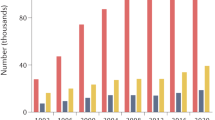Abstract
The use of animal organs could potentially alleviate the critical worldwide shortage of donor organs for clinical transplantation. Because of the strong immune response to xenografts, success will probably depend upon new strategies of immune suppression and induction of tolerance. Here we report our initial results using α-1,3-galactosyltransferase knockout (GalT-KO) donors and a tolerance induction approach. We have achieved life-supporting pig-to-baboon renal xenograft survivals of up to 83 d with normal creatinine levels.
This is a preview of subscription content, access via your institution
Access options
Subscribe to this journal
Receive 12 print issues and online access
$209.00 per year
only $17.42 per issue
Buy this article
- Purchase on Springer Link
- Instant access to full article PDF
Prices may be subject to local taxes which are calculated during checkout

Similar content being viewed by others
References
Galili, U., Wang, L., LaTemple, D. C. & Radic, M. Z. Subcell. Biochem. 32, 79–106 (1999).
Good, A. H. et al. Transplant. Proc. 24, 559–562 (1992).
Xu, Y. et al. Transplantation 65, 172–179 (1998).
Kozlowski, T. et al. Transplantation 67, 18–30 (1999).
Kobayashi, T. et al. Transplantation 64, 1255–1261 (1997).
Lambrigts, D., Sachs, D. H. & Cooper, D. K. Transplantation 66, 547–561 (1998).
Lai, L. et al. Science 295, 1089–1092 (2002).
Kolber-Simonds, D. et al. Proc. Natl. Acad. Sci. USA 101, 7335–7340 (2004).
Dai, Y. et al. Nat. Biotechnol. 20, 251–255 (2002).
Kamano, C. et al. Proc. Natl. Acad. Sci. USA 101, 3827–3832 (2004).
Yamada, K. et al. J. Immunol. 164, 3079–3086 (2000).
Yamada, K. et al. Transplantation 76, 530–536 (2003).
Yamada, K. et al. Transplantation 68, 1684–1692 (1999).
Barth, R. N. et al. Transplantation 75, 1615–1624 (2003).
LaMattina, J. C. et al. Transplantation 73, 826–831 (2002)
Acknowledgements
The authors wish to thank I. McMorrow for her review of the manuscript, S. Arn for herd management and quality control and M. Doherty, E. Samelson-Jones and B. Wong for help in manuscript preparation. D.H. Sachs, A. Shimizu, J. Fishman, D.K. Cooper and K. Yamada were consultants to Immerge Biotherapeutics, Inc. This work was supported in part by the US National Institutes of Health Program Project 1P01A45897 and by a Sponsored Research Agreement between the Massachusetts General hospital and Immerge Biotherapeutics, Inc.
Author information
Authors and Affiliations
Corresponding author
Ethics declarations
Competing interests
The following authors were employees of Immerge BioTherapeutics Inc. at the time of the study: Clive Patience, Robert J. Hawley, Julia Greenstein, Henk-Jen Shuurman and Michele Awwad.
The following authors were consultants of Immerge BioTherapeutics Inc. at the time of the study: David H. Sachs, Jay A. Fishman, Kazuhiko Yamada, David K.C. Cooper and Akira Shimizu.
Supplementary information
Supplementary Fig. 1
Histology of representative vascularized thymic grafts: B113 on day 68. (PDF 179 kb)
Supplementary Fig. 2
Complement-mediated cytotoxicity of anti-non-Gal antibodies before xenotransplantation and on the day of death. (PDF 54 kb)
Rights and permissions
About this article
Cite this article
Yamada, K., Yazawa, K., Shimizu, A. et al. Marked prolongation of porcine renal xenograft survival in baboons through the use of α1,3-galactosyltransferase gene-knockout donors and the cotransplantation of vascularized thymic tissue. Nat Med 11, 32–34 (2005). https://doi.org/10.1038/nm1172
Received:
Accepted:
Published:
Issue Date:
DOI: https://doi.org/10.1038/nm1172
This article is cited by
-
Progress in xenotransplantation: overcoming immune barriers
Nature Reviews Nephrology (2022)
-
Human immune reactivity of GGTA1/CMAH/A3GALT2 triple knockout Yucatan miniature pigs
Transgenic Research (2021)



